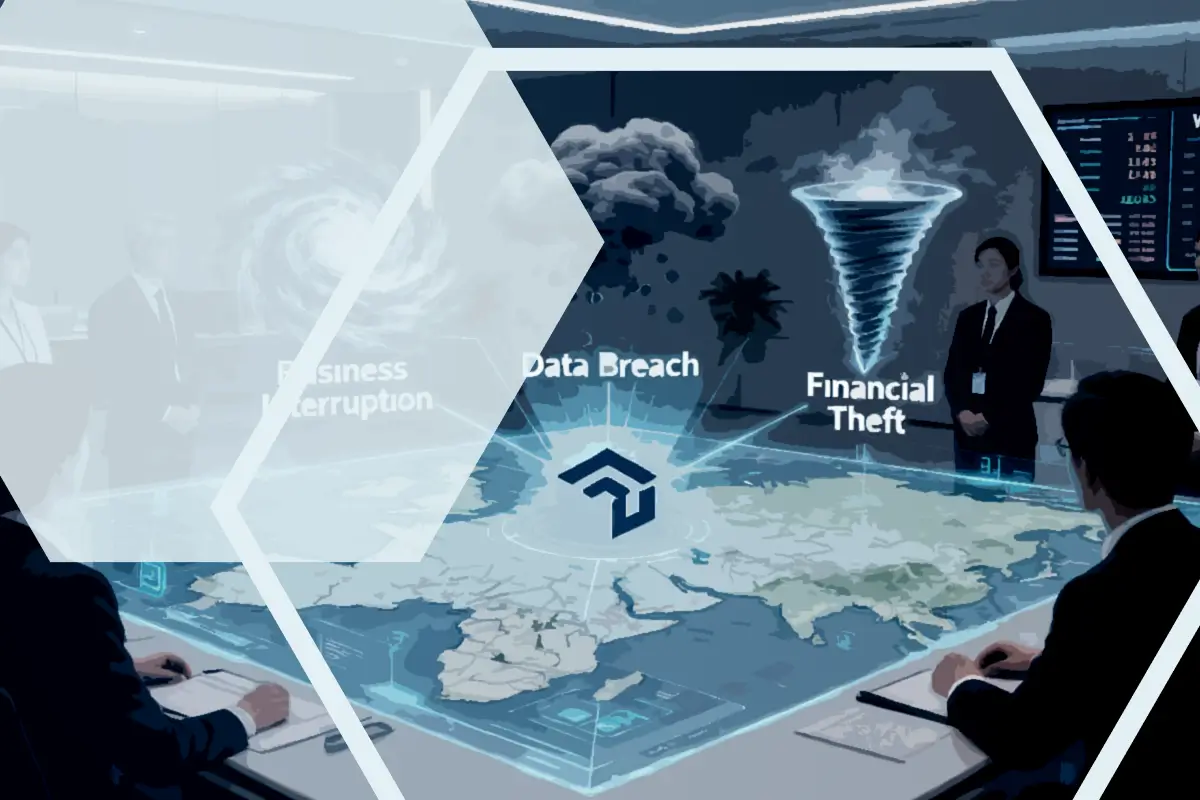Cyber risk presents a growing threat to business security and longevity, with a new cyber attack occurring every 40 seconds. Cyber Risk Quantification (CRQ) involves assigning numerical values to the financial impact of these cyber threats. This practice helps organizations understand and manage cyber risks by allowing them to evaluate their economic consequences to support risk mitigation activities and effectively manage their cybersecurity resources.
This article will answer how CRQ works, why it’s essential for modern organizations, the different types of risk quantification methodologies, and when to use which approach.

Key Takeaways
- Cyber Risk Quantification (CRQ) translates complex cyber threats into measurable financial terms, providing clear insights into their potential economic impact on the organization.
- CRQ enables better strategic decision-making by helping organizations prioritize their cybersecurity efforts based on the financial severity and likelihood of cyber risk.
- Using consistent and understandable financial metrics, CRQ bridges the communication gap between technical teams and executives, ensuring a common ground for more straightforward discussions.
What is Cyber Risk Quantification (CRQ)
Cyber risk quantification (CRQ) converts complex cyber threats into understandable monetary terms. It effectively assesses how these threats might affect an organization’s financial health. CRQ can include the potential economic impact of various cyber events, such as business interruption, data privacy breaches, financial theft and fraud, or ransomware. Assessing these cyber events helps organizations prioritize and manage their cybersecurity efforts more effectively.
Why Cyber Risk Quantification is Essential
Cyber Risk Quantification (CRQ) is essential for organizations to manage their cyber risk exposure and improve their cyber risk resilience. Using CRQ, organizations can facilitate strategic decision-making at the highest levels, allocate resources effectively, improve communication with stakeholders, comply with regulations, and better understand their cyber risk posture.
Improved Decision-Making and Resource Allocation
CRQ helps you focus on the most critical risks, prioritize problem-solving activities, and use resources effectively. By evaluating the financial impact of potential cyber threats, your organization can better understand the materiality of cyber risks and allocate resources accordingly to improve overall security. For instance, gaining a clear understanding of the economic impact and likelihood of various potential cyber incidents simplifies the prioritization of the most significant risks.

Enhanced Communication with Stakeholders
A common language for cyber risks is necessary so that all stakeholders understand the implications. Using simple and consistent terminology helps bridge gaps between technical teams and executives.
For example, explaining how a cyber incident could lead to business interruption, resulting in days of halted operations and financial losses for the organization, helps everyone understand the urgency and significance of a potential cyber incident. This improved clarity can lead to increased support and funding for cybersecurity initiatives. Additionally, quantifying cyber risks supports reporting these risks to the boardroom, allowing oversight of cyber risk and facilitating company-wide strategic decisions.

Better Understanding of the Organization’s Overall Risk Posture
CRQ provides a comprehensive view of your organization’s cyber risk posture. You gain deeper insight into vulnerabilities and potential economic consequences by systematically assessing and quantifying risks. CRQ also enables the management of cybersecurity initiatives and their performance across different business entities using KPIs expressed in financial terms. This understanding supports the development of effective cyber risk mitigation strategies to reduce the organization’s exposure to cyber threats and significantly improve resilience against potential threats.

Compliance with Regulations and Industry Standards
CRQ assists organizations in meeting different regulations and industry standards that mandate a risk-based cybersecurity approach. It supports a compliance framework by quantifying and reporting cyber risks, allowing your organization to demonstrate due diligence and board expertise in managing them. The latter is a growing requirement under recently issued cyber disclosure regulations, such as the SEC cyber disclosure for publicly registered US-based companies. Adhering to CRQ can help organizations avoid costly fines, limit personal liability and enhance their cybersecurity governance framework.
Top-down versus Bottom-up Risk Quantification Methodologies
We can classify cyber risk quantification into two main approaches: top-down and bottom-up. Understanding the difference between these two methodologies can help you choose the best approach for your organization’s needs. Top-down methods prioritize strategic objectives, while bottom-up methods focus on detailed asset-level analysis.

Top-down Cyber Risk Quantification
Top-down CRQ focuses on calculating a company’s overall risk potential to support strategic decision-making at the upper levels of the organization. It examines how cyber risk affects the overall business and often involves assessing the consequences of significant cyber incidents in financial terms.
The top-down approach promotes:
- Strategic cyber investments by focusing on key business risks,
- Simplified decision-making by tying risk factors directly to business impacts,
- Executive understanding of the importance and urgency of cyber risks with high-level summaries.
Squalify specializes in top-down cyber risk quantification, assisting organizations in strategically managing cyber threats.
Bottom-up Cyber Risk Quantification
Bottom-up CRQ focuses on operational decision-making. It begins at the asset level, evaluating the risk of individual systems, applications, or data assets. This method provides a detailed view of vulnerabilities and threats to understand how different cyber risks affect day-to-day operations.
The bottom-up approach supports:
- Comprehensive understanding of specific risks associated with individual assets,
- Identifying specific security weaknesses,
- Flexibility by addressing unique aspects of each asset.
Popular bottom-up methodologies consist of FAIR (Factor Analysis of Information Risk) for quantitative risk assessment, as well as the qualitative methodologies OCTAVE (Operationally Critical Threat, Asset, and Vulnerability Evaluation), and NIST SP 800-30.
When to Choose Which CRQ Methodology
Bottom-up and top-down quantification methodologies significantly differ in speed and practicality of results. Bottom-up quantification focuses on technical risk analysis at the operational level. At the same time, the top-down approach provides valuable insights for enterprise-wide strategic decision-making at the executive and boardroom levels. Even if you use a bottom-up methodology, you will benefit from the top-down risk quantification approach, as it provides a much leaner, efficient, and scalable approach to financially focused risk management for the entire organization.
Combining both CRQ methodologies offers a comprehensive view of cyber risk, supporting strategic planning and operational adjustments. For example, you can use a top-down assessment (Squalify) to understand the financial impact of cyber risk and your cybersecurity investment needs at an enterprise-wide level, informing a board-level discussion. You can then complement these findings with a bottom-up methodology (e.g. FAIR) to learn more about the technical details of cyber risk. This dual approach ensures that all levels of the organization are prepared to handle cyber risks holistically.
Challenges and Considerations in Cyber Risk Quantification
Understanding the challenges and considerations in cyber risk quantification ensures your organization is prepared for effective cyber risk management.
Address the Complexity of Quantifying Cyber Risks Accurately
Quantifying cyber risks accurately is difficult due to the ever-changing threat landscape. Each threat differs in likelihood and potential impact, so clearly understanding your organization’s assets, vulnerabilities, and the threat landscape is vital. For an accurate cyber risk assessment, reliable data is essential to produce correct results. Therefore, access to historical cyber loss data that can provide insights into the actual business impact of cyber incidents is crucial.
Squalify’s top-down approach facilitates cyber risk quantification at the enterprise level. By only requiring easy-to-obtain company information, our approach simplifies and speeds up data gathering, and shifts the focus to discussing strategic risk outcomes rather than estimating inputs. In addition, Squalify leverages over nine years of historical cyber insurance loss data to provide trustworthy and accurate results unmatched in today’s marketplace.
Emphasize the Need for Regularly Updating and Refining the Quantification Process
Cyber threats and organizational structures are constantly evolving. Regular updates to your cyber risk quantification ensure that your risk assessments remain accurate, relevant, and adaptable to company changes and emerging threats. This involves adjusting and refining your quantification and periodically re-evaluating your data sources, models, and assumptions.
Squalify uses a standardized risk model that is successfully applied to over 4,500 quantifications for large enterprises. With us, you can be confident in staying ahead of cyber threats without modifying or maintaining the risk model.
Final Words
In summary, cyber risk quantification (CRQ) is an essential tool for modern organizations seeking to protect their financial stability and operational integrity in the face of constantly evolving cyber threats. By converting complex cyber risks into measurable financial terms, CRQ enables businesses to make informed decisions, effectively allocate resources, and strengthen their overall cyber resilience.
The main points of this article stress the significance of understanding the financial impact of cyber threats, using CRQ to enhance decision-making and resource allocation, and establishing clear communication with stakeholders. Organizations must be distinct in determining which risk quantification methodology to use, whether bottom-up or top-down, as each method has particular strengths and implications.
Adopting CRQ is not only about compliance or best practices; it’s a strategic necessity that enhances an organization’s ability to navigate and thrive in an increasingly digital world. By prioritizing cyber risk quantification, businesses can achieve greater resilience, protect their assets, and secure long-term success in the face of cyber challenges.









